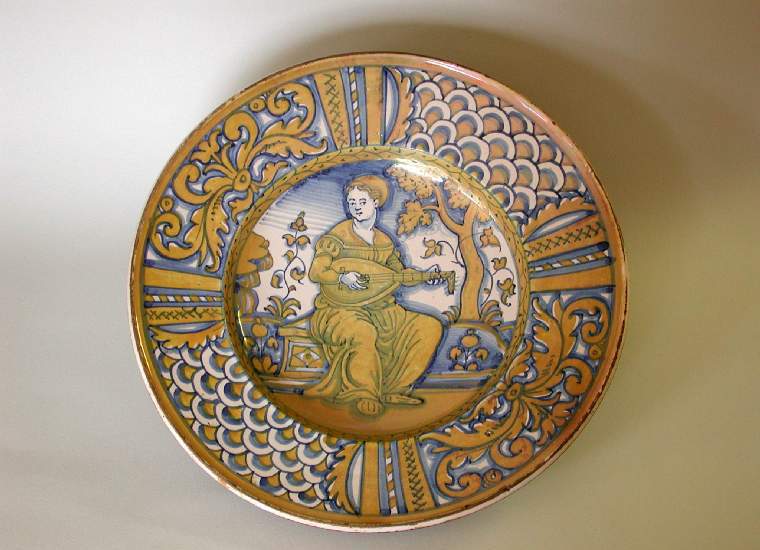Current Location: In storage
Maker(s)
Workshop:
Mancini Workshop
(Probably)
Entities
Categories
Description
Renaissance maiolica dish decorated with blue and gold lustre with a woman playing a lute surrounded by a border of panels of scales, and stylized foliage divided by rays
Buff earthenware, tin-glazed overall; the reverse pale grey with many black speckles and small holes. Painted in blue and with dull silver-yellow lustre.
Shape 61. Circular with slightly sloping rim and rim and wide deep well, standing on a footring pierced by two holes in the correct position for suspension the right way up.
In the middle, a woman playing a lute sits in a garden, with a tree and plants around her. The edge of the well has a border of paired laurel leaves. The rim is divided by radial stripes into four compartments containing alternately scales and a formal flower on a stem flanked by scrolling foliage. A band of yellow lustre encircles the outer edge.
Notes
History note: Unknown before Charles Brinsley Marlay (1831-1912) by whom bequeathed
Legal notes
C.B. Marlay Bequest
Measurements and weight
Diameter: 36.5 cm
Height: 8.2 cm
Acquisition and important dates
Method of acquisition: Bequeathed
(1912)
by
Marlay, Charles Brinsley
Dating
16th Century, Mid
Renaissance
Circa
1545
-
1570
Note
The woman may represent the Sense of Hearing or Music. The figure drawing is similar to that on maiolica attributed to the Mancini workshop in Deruta, such as a panel of the 'Virgin and Child with Saints' in the Cora collection at the Museo Internazionale delle Ceramiche, Faenza. Lustred dishes decorated in similar style with standing figures of St Barbara, Prudence and Fortitude are in the French national collections.
This dish, however, is a little smaller than most Deruta display dishes (piatti da pompa), and its greyish tin-glazed back and pallid lustre gave rise to doubts about its authenticity. These were shown to be unfounded when thermoluminescence analysis by the Oxford Research Laboratory of Archaeology and the History of Art in 1994 estimated that the sample was fired between 300 and 460 years ago. This result may support the hypothesis that some display dishes with tin-glazed backs were made at the end of the date range assessed for this type, and need not be regarded with suspicion unless there are discrepancies between the style of painting and the estimated date.
School or Style
Renaissance
People, subjects and objects depicted
Components of the work
Decoration
composed of
high-temperature colour
( blue)
reduced pigment lustre
( dull silver-yellow lustre)
Materials used in production
Tin-glaze
Earthenware
Techniques used in production
Throwing
: Buff earthenware, tin-glazed overall; the reverse pale grey with many black speckles and small holes. Painted in blue and with dull silver-yellow lustre.
Tin-glazing
References and bibliographic entries
Related exhibitions
Identification numbers
Accession number: MAR.C.56-1912
Primary reference Number: 48491
Stable URI
Audit data
Created: Saturday 6 August 2011
Updated: Tuesday 19 November 2024
Last processed: Wednesday 14 May 2025
Associated departments & institutions
Owner or interested party:
The Fitzwilliam Museum
Associated department:
Applied Arts




